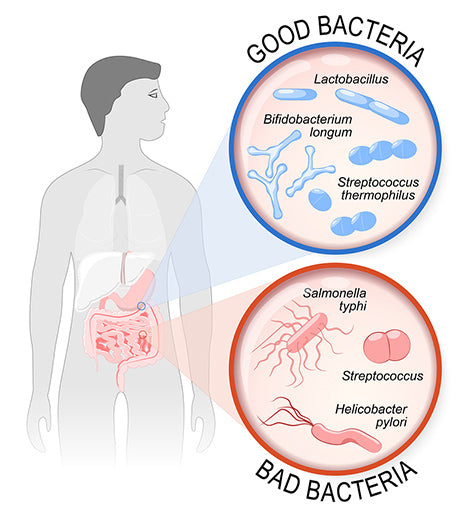Epidemic – Protect Yourself from Viral Infection
Editor's Note: This article was published in February 2020 prior to COVID-19 being declared a pandemic. The information on immune support strategies and precautionary exposure reduction apply to colds, flus, and viruses in general. Related Reading: See the follow up piece COVID-19 Healthy Living Strategies.
With the steady news coverage on the spread of the new coronavirus and the efforts to contain it, concern about viruses continues to increase. While relatively little information about this newest strain is available, there are time-tested methods to help keep your immune system healthy, reduce your chances of getting sick, and aid recovery.

There are many viral strains of varying severity that fall under the large family term of "corona viruses." According to the US Centers for Disease Control and Prevention, some can cause the common cold. The coronavirus that's been the focus of the world's attention recently has been the most talked-about strain since SARS (Severe Acute Respiratory Syndrome), another coronavirus outbreak that occurred in 2002-2003.
This strain (called SARS-CoV-2) is what causes the infectious disease COVID-19 (coronavirus disease 2019), and was first identified in China in late 2019. Like SARS, this coronavirus is thought to be similar to viruses found in animals like bats and pangolins which were transmitted to humans. It remains early, and research continues into this strain's exact source and potential treatments. Initial symptoms of COVID-19 are flu-like, with muscle pain, sore throat, fever, shortness of breath, and coughing, with some experiencing more serious complications including pneumonia. With no antiviral medication for COVID-19 yet, the best approach (as for any flu virus infection) is to reduce the chance of exposure and take steps to increase immunity to help prevent getting sick.

Consider 'regular' influenza. According to the CDC, the flu has about a 0.1% mortality rate, much lower than the estimated rate from COVID-19. But in absolute terms, it's much higher, since North Americans are at a far greater risk of coming into contact with a strain of the flu. In the United States, there were 26 million cases resulting in 310,000 hospitalizations and 10,000 to 25,000 deaths in just four months (October 2019 to January 2020). The flu kills 50,000 to 70,000 people annually in the USA.
How COVID-19 in particular will play out is yet to be seen, but new viruses with different properties will continue to pose a threat to public health. With today's integrated global economy, rapid urbanization, ever-increasing travel, and changing environment, viral outbreaks of varying severity will continue to happen in the future.
Symptoms of COVID19 compared to the flu and the common cold.
|
Clinical Symptoms |
COVID19 |
Influenza |
Common |
|
Fever |
✓ |
✓ |
|
|
Cough |
✓ |
✓ |
✓ |
|
Runny Nose |
|
✓ |
✓ |
|
Nasal Congestion |
|
|
✓ |
|
Sneezing |
✓ |
✓ |
|
|
Sore Throat |
|
✓ |
|
|
Headache |
✓ |
|
|
|
Shortness of Breath |
✓ |
|
|
|
Yellow/Green Phlegm |
✓ |
|
|
|
Vomiting |
|
✓ |
|
|
Diarrhea |
|
✓ |
|
|
Extreme Fatigue |
✓ |
|
|
|
Muscle Pain |
|
✓ |
|
|
X-ray Shows |
✓ |
|
|
The flu and common cold share some symptoms but affect individuals differently in terms of duration and severity. Those with compromised immune systems (including seniors) are among those who can be most susceptible to getting sick. Fortunately, there are steps we can take to help keep our immune systems strong.
Avoiding Exposure
Daily lifestyle factors that can help reduce the risk of catching a viral infection include nasal rinsing, frequent, thorough handwashing, and disciplining ourselves to not touch our face and eyes. Use a humidifier and an air purifier to remove airborne particles in your home and office. New air disinfection systems that produce OH radicals can also help reduce exposure by eliminating many airborne pathogens like viruses and bacteria in our living environments. In the event of a local outbreak, take care to avoid large crowds and touching common surfaces when possible.
Nutritional and Lifestyle Support
A strong immune system can help prevent, and if we do get sick, reduce the symptoms and shorten the duration of the common cold, flu, and respiratory tract infections. Getting sufficient sleep (at least eight hours each night), sun exposure, exercise, and learning how to manage stress through supplementation and mindful meditation can all have a significant positive effect on our immune system.
There are a variety of herbs, medicinal mushrooms, vitamins, and minerals that can help maintain healthy immune function including garlic, andrographis, Arthrospira platensis, astragalus, zinc, Japanese honeysuckle, forsythia, and European elderberry. Douglas Laboratories is a premier research-based company whose products health professionals have recommended for many years; their Immunity formula contains all these ingredients. I also recommend at 4,000-10,000 IU of vitamin D per day during the winter months, with 180 to 250 mcg of vitamin K2 to ensure calcium is incorporated into the skeletal structure.
Some family physicians use short term high doses of vitamin D3 (10,000 IU, three times a day) for two to three days to address cold and flu symptoms. Results can be dramatic; some see a complete resolution of symptoms in 48-72 hours.
Oral supplementation of high doses of vitamin C (3000 mg or more daily spread out in smaller doses) has also been shown to help prevent and treat respiratory and systemic infections. I recommend formulas that use Transport C-PLUS, a buffered form that is stomach-friendly and more bioavailable than regular vitamin C.
Derived from nuts, seeds, fruits, and vegetables (rice bran is the richest source), plant sterols can activate cells that balance and modulate the immune system. These compounds can be effective in shrinking a swollen prostate gland and as nutritional support for treating chronic viral infections, allergies, rheumatoid arthritis, tuberculosis, and auto-immune diseases.
The result of 12 years of research, Immunidiol is a combination of high-potency Asian ginseng and astragalus extracts. Featured in Purica Prevent, this 'immunity optimizer' has been clinically proven to support immune response (especially in the elderly), by increasing the activity of cells that protect the body.
As noted above, forsythia and honeysuckle extracts have potent immune-boosting properties. Prairie Naturals Cold & Cough adds Baikal skullcap to help reduce fever, sore throat, and coughing. Also known as Shuang Huang Lian, the powerful combination of these three herbs has been used for many years in China to help treat influenza and respiratory infections.
Medicinal mushrooms including reishi, shiitake, cordyceps, Agaricus blazei, Coriolus versicolor, and maitake have been shown to help modulate the immune system, with compounds that exhibit antiviral effects. Immune 7 combines these powerful mushrooms with a complementary antioxidant complex.

Gut Health
As our immune system is largely based in the gut, it's imperative that we nourish and "feed" our inner garden. Our small and large intestines contain more antibody-producing cells than any other part of the body and require probiotic bacteria and prebiotic fibre to function optimally. While this is my final recommendation, it's also the most important.
Our gut is home to trillions of bacteria, some friendly (probiotic), and some unfriendly (pathogenic). Collectively, the various microorganisms in our body are called microbiota. "Prebiotic" is the term used to identify specific types of carbohydrates that boost healthy bacteria levels by providing food for the good bacteria in the large bowel. I recommend two to three tablespoons of potato starch daily, dissolved in any cold drink. Called a resistant starch (as it is resists normal digestion), potato starch is a superfood for the digestive system that has many benefits including improving insulin sensitivity, energy levels, sleep quality, and immune function.
Inulin is another prebiotic fibre that is soluble in water and almost tasteless. With similar but complementary benefits to resistant starch, inulin promotes healthy blood sugar levels, slows digestion, improves the absorption of nutrients, and supports bowel health.

Be cautious with the use of antibiotics when possible. Antibiotics are not "targeted missiles," they're weapons of mass destruction that indiscriminately kill all bacteria – good and bad. Even a short course of antibiotics can disrupt the gut's microbiome and potentially compromise immune function. If prescribed by your health professional, be sure to discuss ways to rebuild the microbiome by taking prebiotic and probiotic supplements. Eating more fermented foods like kefir and sauerkraut is an easy and nutritious way to boost good gut bacteria.
Infectious diseases remain a serious health concern, but for most people, worrying about exposure to one specific strain might miss the bigger picture. Simple steps like washing your hands, avoiding touching your face, and supplementing your diet can keep your immune system strong and help you stay healthy this flu season, and next.
Health Disclaimer. Copyright ©2020. Nathan Zassman is a trained nutrition practitioner and the owner of Aviva Natural Health Solutions.
Related Reading: See Cold & Flu Season - Keys to Prevention
